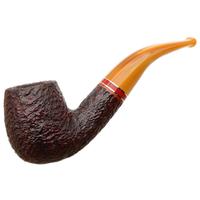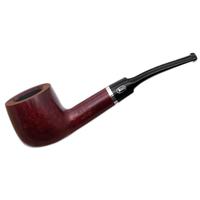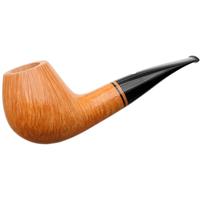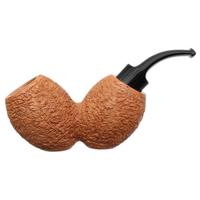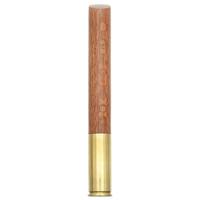You seem to be extremely wisened when it comes to tobacco as far as I can tell from a year of lurking and looking for tips to optimize my cellar and general pipe smoking experience. Question- would it be prudent to simply jar all of ones tins? Round, square, can, or otherwise? Is this the most surefire way of preserving the tobacco? I cannot find any reference of GL Pease saying one way is superior to the other. And admittedly i can smell the tinned part of my cellar and it makes me concerned...Greg's changed his stance on aging in tins. He found too many failures with the square tins in his cellar - he's been cellaring for decades - and now recommends jarring as soon as possible and then letting the tobacco age in the jar.
A Question About Aging
- Thread starter davidsaulmarshall
- Start date
You are using an out of date browser. It may not display this or other websites correctly.
You should upgrade or use an alternative browser.
You should upgrade or use an alternative browser.
- Status
- Not open for further replies.
That is the failsafe way to go. Another idiot proof thing you can do is put the whole tins in a Mylar and heat seal it. I prefer to leave my tins intact so that’s my method if I have any concerns.You seem to be extremely wisened when it comes to tobacco as far as I can tell from a year of lurking and looking for tips to optimize my cellar and general pipe smoking experience. Question- would it be prudent to simply jar all of ones tins? Round, square, can, or otherwise? Is this the most surefire way of preserving the tobacco? I cannot find any reference of GL Pease saying one way is superior to the other. And admittedly i can smell the tinned part of my cellar and it makes me concerned...
You seem to be extremely wisened when it comes to tobacco as far as I can tell from a year of lurking and looking for tips to optimize my cellar and general pipe smoking experience. Question- would it be prudent to simply jar all of ones tins? Round, square, can, or otherwise? Is this the most surefire way of preserving the tobacco? I cannot find any reference of GL Pease saying one way is superior to the other. And admittedly i can smell the tinned part of my cellar and it makes me concerned...
Prudent and practical are different beasts. I just finished organizing and inventorying and have well over 1500 tins. I'm willing to accept some small amount of loss vs the expense and effort to jar that many tins. Not to mention the additional space it would require. I have taken a fair quantity and placed them in 5 gallon mylar bags that I heat sealed for ten year plus storage.



I wouldn't put them all on one jar. Use 3 or more so you can sample along the way. Age doesn't make tobacco magical, it is best practise to sample along the way using smaller jars so you can find the sweet spot according to your tasteThanks for all the information guys. I was asking this question because I've been thinking about how to age the four or five tins of Sutliff Cringle Flake I purchased this holiday season. For reasons too complex to explain, I won't see these tins for at least 3 years, so I think I'll just jar them together and seal the mason jar with some wax.
Think of it like wine, it is a living breathing thing and don't forget to take notes
Certainly with such a massive collection of tins I would not even consider embarking on the insurmountable task that would be jarring each and every one of them individually, however I only possess 50 or so tins. If jarring is indeed the ideal than I suppose I have no excuse. My only regret would be the loss of beautiful tin art that Id have little choice but to discard. Still. All something to think about.Prudent and practical are different beasts. I just finished organizing and inventorying and have well over 1500 tins. I'm willing to accept some small amount of loss vs the expense and effort to jar that many tins. Not to mention the additional space it would require. I have taken a fair quantity and placed them in 5 gallon mylar bags that I heat sealed for ten year plus storage.
View attachment 14694View attachment 14695
View attachment 14696
Certainly with such a massive collection of tins I would not even consider embarking on the insurmountable task that would be jarring each and every one of them individually, however I only possess 50 or so tins. If jarring is indeed the ideal than I suppose I have no excuse. My only regret would be the loss of beautiful tin art that Id have little choice but to discard. Still. All something to think about.
Buy 7 mm mylar bags and seal the entire tin inside the bag then. You could buy 50 bags of adequate size for less than $50. Heat seal with a clothes iron or curling iron.
Buy 7 mm mylar bags and seal the entire tin inside the bag then. You could buy 50 bags of adequate size for less than $50. Heat seal with a clothes iron or curling iron.
do you vacuum seal them? or just seal them without vacuuming? is there a need for vacuum?
There is no need to, assuming that the bag isn’t way too big for the tin or tins sealed. Just press out some of the air before sealing.do you vacuum seal them? or just seal them without vacuuming? is there a need for vacuum?
I just jarred some 10 year old tins. They seemed to stay sealed pretty well but I've had others pop.
Good question! My take on the square and rectangular tins is that they are not 100% sealed, are slowly leaking from the get go, and over time will lose their seal. The round tins seem to do better and I'm thinking, son of an engineer that I am, that the pressure of the seal on a circular perimeter is more evenly distributed than on the square and rectangular tins and that the circular tins have a slight screw down thread, while the square and rectangular tins have only a gasket, which also helps. That said, I've bagged my older tins in heavy food grade Mylar, in the hope that the added barrier will be enough to keep the content from drying out. And there are other factors involved, such as the use of vinegar as a preservative, which can corrode a tin over time.You seem to be extremely wisened when it comes to tobacco as far as I can tell from a year of lurking and looking for tips to optimize my cellar and general pipe smoking experience. Question- would it be prudent to simply jar all of ones tins? Round, square, can, or otherwise? Is this the most surefire way of preserving the tobacco? I cannot find any reference of GL Pease saying one way is superior to the other. And admittedly i can smell the tinned part of my cellar and it makes me concerned...
And cellarers who say they haven't had a tin fail are largely not dealing with 20+ year old tins. Cellaring didn't become widespread until the early 2000's. Most of us just bought what we needed for immediate use.
A number of my GL Pease canister tins from the early 2000's corroded from the inside out. Bad bets for aging include the original Renaissance, Bohemian Scandal, and Haddos. Renaissance did resuscitate fairly well. Haddo's becomes stale and quite nasty. I won't spend money on these, but will happily take them for free since that's all they are worth to me at this point.
Last year I bit the bullet and jarred all of my tins of Haddo's and am glad that I did, since some corrosion was forming at the solder join in the 8oz and 16 oz tins.
I interrupted their aging. Boo hoo. Still better than opening up a rust filled tin of mummy dust.
Of course, there will always be exceptions, but that does not disprove the trend. It's one reason that I've stopped buying vintage square and rectangular tins. Those 20 years old or older have largely been compromised and the contents have dried out.
And not all blends respond well to rehydration, one case being St Bruno and another being Haddos. But St Bruno's Ogden's base tobaccos can sometimes be slightly revived and provide an interesting smoke, though the topping is long gone. They're worth a couple of bucks as a gamble. I'm smoking some mid 90's St Bruno that I rehydrated from a failed tin, and it's not a bad smoke, just not Full St Bruno.
And it's not just the C&D tinned GL Pease tins from 2000 thru 2005 that have problems. I've had a couple of disappointments with Rattrays blends in the tall canisters from the 1990's.
After I started a thread in the spring of 2018 about the Pease tins:
Look CAREFULLY Before You Leap :: Pipe Tobacco Discussion
With all of the crazy "collectible" tin buying action on eBay I've been following a lot of auctions. Several have caught my eye because they are offering something a bit different. Here's one that just completed...
pipesmagazine.com
On the plus side, I've had some marvelous experiences with old blends, most recently tins of Edgeworth Slices, some '60's era Edgeworth Ready Rub from a can that opened with an audible whoosh, some '50's era Craven's Mixture that had faded a bit but still tasted fine, some '90's era Christmas Cheer that had developed a wonderful sweetness, some '80's era Balkan Sobranie that brought back some happy memories, and others that came from cutter tops.
So it's very much a crap shoot when dealing with really old tobaccos.
As for preserving tobaccos for long term aging, from my experience it's hard to beat a jar, or a cutter top.
You can put tins in jars and hope for the best, but some blends, like Haddo's are better just jarred to avoid corrosion from the inside out.
And keep in mind that all tobaccos, with the possible exception of burley, have a life span. They mature, peak, and fade. Flavorings fade, maybe not for a decade more or less, but eventually. Virginias last a long time, but they too peak and fade. They just take longer to do so than Latakia.
do you vacuum seal them? or just seal them without vacuuming? is there a need for vacuum?
I would recommend against vacuum dealing. There is a minimum amount of oxygen in the bag anyway. Seems to me it is possible the vacuum in the bag could create a positive pressure in the tin inside of it encouraging the tin seal to leak. Kind of the law of unintended consequences.
Pulling a little pressure vacuum doesn’t necessarily mean you are eliminating oxygen from the mix.I would recommend against vacuum dealing. There is a minimum amount of oxygen in the bag anyway. Seems to me it is possible the vacuum in the bag could create a positive pressure in the tin inside of it encouraging the tin seal to leak. Kind of the law of unintended consequences.
A bit of oxygen ain’t gonna hurt the blend,
but will likely facilitate the good result over time.
That said, it’s rather useless to try to evacuate all air in a Mylar packing.
Just squeeze it and seal it.
This was a great post. Thanks for the insightGood question! My take on the square and rectangular tins is that they are not 100% sealed, are slowly leaking from the get go, and over time will lose their seal. The round tins seem to do better and I'm thinking, son of an engineer that I am, that the pressure of the seal on a circular perimeter is more evenly distributed than on the square and rectangular tins and that the circular tins have a slight screw down thread, while the square and rectangular tins have only a gasket, which also helps. That said, I've bagged my older tins in heavy food grade Mylar, in the hope that the added barrier will be enough to keep the content from drying out. And there are other factors involved, such as the use of vinegar as a preservative, which can corrode a tin over time.
And cellarers who say they haven't had a tin fail are largely not dealing with 20+ year old tins. Cellaring didn't become widespread until the early 2000's. Most of us just bought what we needed for immediate use.
A number of my GL Pease canister tins from the early 2000's corroded from the inside out. Bad bets for aging include the original Renaissance, Bohemian Scandal, and Haddos. Renaissance did resuscitate fairly well. Haddo's becomes stale and quite nasty. I won't spend money on these, but will happily take them for free since that's all they are worth to me at this point.
Last year I bit the bullet and jarred all of my tins of Haddo's and am glad that I did, since some corrosion was forming at the solder join in the 8oz and 16 oz tins.
I interrupted their aging. Boo hoo. Still better than opening up a rust filled tin of mummy dust.
Of course, there will always be exceptions, but that does not disprove the trend. It's one reason that I've stopped buying vintage square and rectangular tins. Those 20 years old or older have largely been compromised and the contents have dried out.
And not all blends respond well to rehydration, one case being St Bruno and another being Haddos. But St Bruno's Ogden's base tobaccos can sometimes be slightly revived and provide an interesting smoke, though the topping is long gone. They're worth a couple of bucks as a gamble. I'm smoking some mid 90's St Bruno that I rehydrated from a failed tin, and it's not a bad smoke, just not Full St Bruno.
And it's not just the C&D tinned GL Pease tins from 2000 thru 2005 that have problems. I've had a couple of disappointments with Rattrays blends in the tall canisters from the 1990's.
After I started a thread in the spring of 2018 about the Pease tins:
I got PMs from several people about McClelland tins from the 1990's that had corroded from the inside out. Not many, but it does happen.Look CAREFULLY Before You Leap :: Pipe Tobacco Discussion
With all of the crazy "collectible" tin buying action on eBay I've been following a lot of auctions. Several have caught my eye because they are offering something a bit different. Here's one that just completed...pipesmagazine.com
On the plus side, I've had some marvelous experiences with old blends, most recently tins of Edgeworth Slices, some '60's era Edgeworth Ready Rub from a can that opened with an audible whoosh, some '50's era Craven's Mixture that had faded a bit but still tasted fine, some '90's era Christmas Cheer that had developed a wonderful sweetness, some '80's era Balkan Sobranie that brought back some happy memories, and others that came from cutter tops.
So it's very much a crap shoot when dealing with really old tobaccos.
As for preserving tobaccos for long term aging, from my experience it's hard to beat a jar, or a cutter top.
You can put tins in jars and hope for the best, but some blends, like Haddo's are better just jarred to avoid corrosion from the inside out.
And keep in mind that all tobaccos, with the possible exception of burley, have a life span. They mature, peak, and fade. Flavorings fade, maybe not for a decade more or less, but eventually. Virginias last a long time, but they too peak and fade. They just take longer to do so than Latakia.
Jars aren't 100% reliable also. My family relies on jarring about 80% of our foods, and have for decades. I also have several hundred pounds of tobaccos in tins and jars. I have had less tins, square and round, fail me than jars. And, the couple of tins that have failed me, I suspect were opened while on the shelf of the B&M before I bought them.
If you wonder whether a tin is failing you, check by trying to open it, which is my standard practice now before shelving them. If you wonder whether a jar will fail you, remove the ring and hold the jar up by the lid.
There is way less science going on with this whole jar everything notion than with climate change. And, it makes way less sense to me. Trade a fear for something even less reliable? But, this is me. You can all do what you want. But, most of what you pay for with buying tins is the damned tin, ha ha. And, taking a tobacco that costs four times as much because of the tin, then dumping it into a jar like a common cheap bulk blend makes me giggle.
If you wonder whether a tin is failing you, check by trying to open it, which is my standard practice now before shelving them. If you wonder whether a jar will fail you, remove the ring and hold the jar up by the lid.
There is way less science going on with this whole jar everything notion than with climate change. And, it makes way less sense to me. Trade a fear for something even less reliable? But, this is me. You can all do what you want. But, most of what you pay for with buying tins is the damned tin, ha ha. And, taking a tobacco that costs four times as much because of the tin, then dumping it into a jar like a common cheap bulk blend makes me giggle.

How old are your tins?I have had less tins, square and round, fail me than jars.
Interesting about the jars, so far I've not had any lose a seal, but none of mine are more than 8 to 10 years old.
How old are your tins?
Interesting about the jars, so far I've not had any lose a seal, but none of mine are more than 8 to 10 years old.
I have purchased older tins... but the bulk of my cellar started the year I joined here... and, many of my tins came from B&M's that were already aged on the shelves of the B&M... 2013. I see what you are getting at, but like the common cellerer guy on this forum is going to have bunches of GLP tins from that year that his tins sucked. And, definitely we don't have members here with boxes of cutter tops.
I have way more experience with jars failing. Even with foods that have been canned under pressure, you get the occasional seat that doesn't set. And, with most suggesting that they just put tobacco in the jar and tighten the rim... well, that is done by guys who have no clue as top how jars work.
Tightening the rim does nothing. The rim is designed to merely hold the lid in place until it is set. It does not tighten any further. And, those of us with experience with canning will tell you that a tightened rim doesn't prevent the contents from getting sucked out under pressure.
Sure, sure, when you just pout the tobacco into the jar, set the lid and rim, over time the tobacco creates a natural vacuum, in about a week or so. But, on tiny grain between the rim and lid can cause a lid not to set.
To fully ensure that your jars are sealed, it really is better to just remove the rims and rely on the pressure created in the jar by the tobacco. But, IT STILL IS NOT 100% better than relying on a few stories over the internet to set off a revolt. I have still yet to see the post that Greg made, but that doesn't really matter to me, as my own experience is good enough for me. Yet, I see pictures all the time of Greg's collection of tins full of very old tobaccos on his Instagram. He never shows us a jar full of 1978 Balkan Sobranie, it is always in the original tin.
But logic be damned. You don't have to convince me. This is all led by faith. If one's faith is to jar up all their tins, then have at it. But, as long as guys are proselytizing their faith in jars over tins, I will throw my own views in there.
I mean no insult to any individual, I just think the idea to tin up all jars isn't well thought out. Hate me all you want because of your own ideas, but you may do what you want to your jars.
But logic be damned. You don't have to convince me. This is all led by faith. If one's faith is to jar up all their tins, then have at it. But, as long as guys are proselytizing their faith in jars over tins, I will throw my own views in there.
I mean no insult to any individual, I just think the idea to tin up all jars isn't well thought out. Hate me all you want because of your own ideas, but you may do what you want to your jars.
Well actually, logic is involved, as is some personal experience, and you're right about the chances that not doing ones sealing carefully can result in a failure. You have your personal experience and I have mine. Heavens, why would anyone hate you for that?
All that tobacco scent leaking from perfectly sealed tins? Don't think so. And let's be clear, we're not talking about all tins, we're talking about the square and rectangular metal tins.
BTW, Greg's letter about jarring rather than leaving in the square and rectangular tins was published at the BriarBlues Youtube channel, which I've mentioned here a couple of times, so if you want to read it, there you go. And if you want to ignore it, there you don't go.
Instagram? Nice place to share toys and trophies. Greg would have more old tins than old jars. That's kinda what led to his letter to Mike.
Ultimately people will read these and other people's anecdotal experiences and make up their own minds.
I have stored tobacco in everything ever mentioned in any of these hardy perennial threads, and more. A quote from Dan Jenkins that a friend has framed on his desk comes to mind, as best as I can remember it:
“A man can travel far and wide, all the way from shame to glory, and back again, but he ain’t going to find nothing in this world that is dead solid perfect.”
“A man can travel far and wide, all the way from shame to glory, and back again, but he ain’t going to find nothing in this world that is dead solid perfect.”
I believe people need to understand there is no such thing as a perfect seal. Almost all materials are permeable to a certain degree. The closest thing to a perfect seal is hermetic such as a light bulb or a metal food can. Those have been known to fail as well. Don't be confused thinking that a tin of tobacco isn't leaking. All of them are. The leak is generally slow or small enough that it doesn't affect the product contained within for a very long time, at least to any significant degree. In some cases, the seal completely or partially fails and the product completely dries out over a period of time.
So the real debate should be which approach offers the most reliable seal with the least amount of leakage over a long period of time. Scientific data shows that mason jars are slightly superior to mylar bags but both are shown to be more than adequate for very long term storage if the original seal is right. The last thing I check before sealing a mason jar is to make sure no particles of tobacco or anything else aren't on the rim or the rubber gasket.
I have no idea how long one can realistically expect tins to preserve the tobacco. I know i just reorganized and inventoried around 2,000 tins. These range from a few tins that are 5 to 10 years old with the bulk being 1 to 2 years old. I did not detect any smell on any of the tins. I didn't get around to inventorying my bulk yet but I was looking through it. I noticed some tobacco smell when I opened one of the large totes. So I know at least one of the mason jars are leaking. I didn't notice a smell with any of the mylar bags. That covers around 200 pounds of bulk.
Since there doesn't seem to be much, if any, hard, firm scientific data on long term storage of tobacco, I would think common sense would prevail. I can't imagine trusting tins for storing tobacco well over 10 years. Tins may very well work "good enough" for a high percentage of the time for 20, 30 years or longer but there undoubtedly is going to be some lost. I have taken some amount of my tins and placed them in 5 gallon 7 mm mylar bags. These won't be touched for over 10 years. I feel confident this additional step will minimize the amount of spoilage I experience.
I would add that as I was going through the tin inventory and organization process, I noticed one tin that didn't feel quite right. Turns out, the top twisted right off. Looked like the contents had never been disturbed. Thankfully, it was from 2018 and the tobacco was still good. So I simply added it to the rotation to smoke now.
If I had a smaller inventory, I would mylar bag every tin. The bags are relatively cheap and it is easy to heat seal them. That's just not feasible with the quantity I have. So I expect some small amount of spoilage and am okay with that.
So the real debate should be which approach offers the most reliable seal with the least amount of leakage over a long period of time. Scientific data shows that mason jars are slightly superior to mylar bags but both are shown to be more than adequate for very long term storage if the original seal is right. The last thing I check before sealing a mason jar is to make sure no particles of tobacco or anything else aren't on the rim or the rubber gasket.
I have no idea how long one can realistically expect tins to preserve the tobacco. I know i just reorganized and inventoried around 2,000 tins. These range from a few tins that are 5 to 10 years old with the bulk being 1 to 2 years old. I did not detect any smell on any of the tins. I didn't get around to inventorying my bulk yet but I was looking through it. I noticed some tobacco smell when I opened one of the large totes. So I know at least one of the mason jars are leaking. I didn't notice a smell with any of the mylar bags. That covers around 200 pounds of bulk.
Since there doesn't seem to be much, if any, hard, firm scientific data on long term storage of tobacco, I would think common sense would prevail. I can't imagine trusting tins for storing tobacco well over 10 years. Tins may very well work "good enough" for a high percentage of the time for 20, 30 years or longer but there undoubtedly is going to be some lost. I have taken some amount of my tins and placed them in 5 gallon 7 mm mylar bags. These won't be touched for over 10 years. I feel confident this additional step will minimize the amount of spoilage I experience.
I would add that as I was going through the tin inventory and organization process, I noticed one tin that didn't feel quite right. Turns out, the top twisted right off. Looked like the contents had never been disturbed. Thankfully, it was from 2018 and the tobacco was still good. So I simply added it to the rotation to smoke now.
If I had a smaller inventory, I would mylar bag every tin. The bags are relatively cheap and it is easy to heat seal them. That's just not feasible with the quantity I have. So I expect some small amount of spoilage and am okay with that.
- Status
- Not open for further replies.



